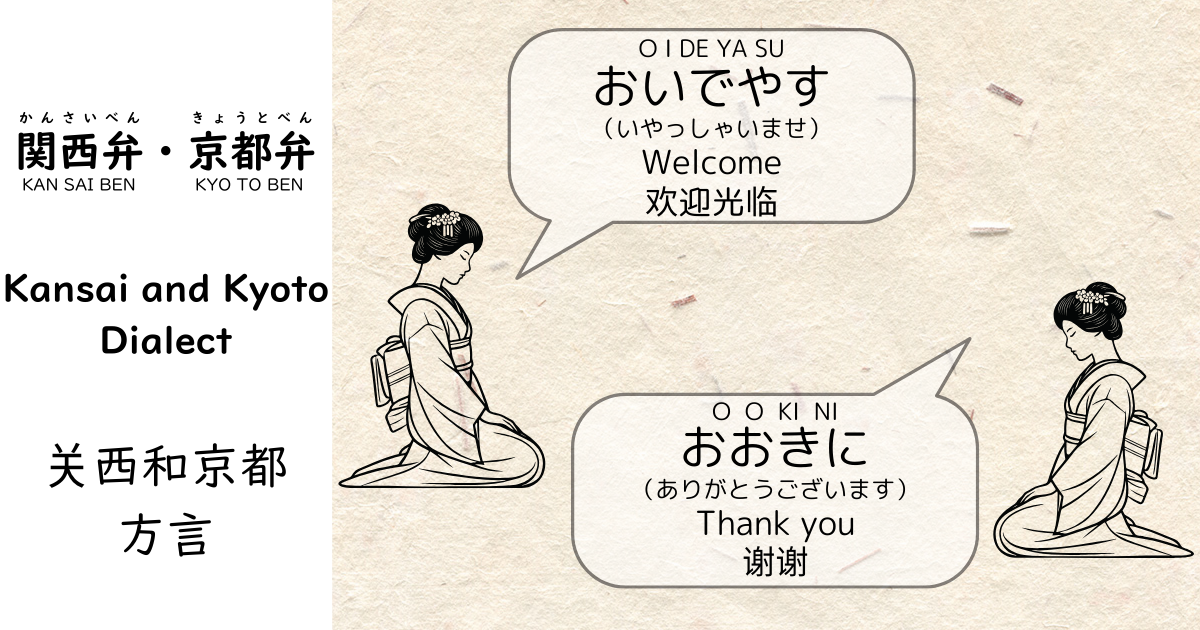
Kansai dialect is one of the most well-known regional dialects in Japan.
If you’ve lived in Japan for a while, you’ve probably heard it before.
So, what makes it different from standard Japanese?
One of the biggest features of Kansai dialect.
—just like many other dialects—is that sentence endings are different.
For example.
Instead of “sou nan da.”
“I see.” or “That’s how it is.”
→Kansai people say “sou yanen.”
Instead of “ikanai.” (“don’t go.”)→ “ikehen.”
And “chigau yo.” (“that’s not right.”) → “chau nen.”
Just by changing the sentence ending a little.
If you do, your Japanese instantly sounds more Kansai-style!
“yanen” and “ten” Instantly Make You Sound Kansai!
“nanda yo” → “yanen”
If you want to sound like you’re from Kansai?
Then, Just start using “yanen”.
If this simple ending could be used,
People will totally think.
“Oh, this person sounds kind of Kansai!”
For example:
- “Suki da yo.” → “Suki yanen.” (I like it!)
- “Sou da yo.” → “Sou yanen.” (That’s right!)
- “Iya nanda.” → “Iya yanen.” (I don’t like it….)
In standard Japanese, phrases like “nanda” or “nano” are often used at the end of sentences.
However, in Kansai dialect, they’re replaced with “(ya) nen.”
“~tan da yo” → “ten”
You’ll often hear “ten” in Kansai dialect when talking about something you did.
—like “~tan da yo” or “~shitan da yo” in standard Japanese.
In short, “ten” is used to express the past tense of a verb.
Here are a few examples:
- “Kinou ittan da yo.” → “Kinou itten.”
(I went yesterday.) - “Sakki tabeta yo.” → “Sakki tabeten.”
(I just ate.) - “Mou itta yo.” → “Mou itten.”
(I already said it.)
In Kansai, it’s super common to end sentences with “ten”, when talking about things that already happened.
“hen” and “hin” – Negative Forms in Kansai Dialect
What is the ending “hen” and “hin” in Kansa dialect?
These are used in the negative form.
The mean of standard Japanese:
“~nai” or “~dekinai” (not doing / can’t do).
“hen” is for verb negation
The most frequently used form is “hen”.
The word is added after the verb stem to mean “not ~”.
For example:
- “Ikanai.” (I don’t go.)
→ “Ikehen.” - “Tabenai.” (I don’t eat.)
→ “Tabehen.” - “Kaeranai.” (I don’t go home.)
→ “Kaerehen.”
In Kansai dialect, just attach “hen” after the verb to make it negative.
It’s really that simple!
In Kyoto, both “ikehen” and “ikahen” are used – but there’s a subtle difference!
What’s the difference between “ikehen” and “ikahen”?
It often depends on whether the person is unable to do something.
Or simply has no intention of doing it.
For example:
- “Ikehen.”
→ Can’t go due to circumstances.
In standard Japanese, this would be “ikenai.” - “Ikahen.”
→ No intention of going.
In standard Japanese, this would be “ikanai.”
The same idea applies to other verbs too:
- “Kakehen.” = “I can’t write (due to something).”
- “Kakahen.” = “I don’t feel like writing.” or “I won’t write.”
It might seem a little tricky at first.
But, don’t worry.
It doesn’t matter if you use ‘ikehen’ for everything!
Kansai people will understand you!
“hin”
Just like “hen,” the ending “hin” is used in Kansai dialect to express negation.
However, it’s usually used with different types of verbs than “hen.”
In many cases, you’ll hear “hin” with specific verbs like “suru” (to do) or “miru” (to see).
For example:
- “Minai.” → “Miihin.”
(I don’t watch / don’t look) - “Okina i.” → “Okihin.”
(I don’t wake up) - “Inai.” → “Iihin.”
(not there / not present)
Perhaps you will hear slightly different ways of saying this.
However, there is no significant difference.
“yaro?” and “chau” Complete the Kansai Vibe!
So far, we’ve looked at the basics:
“yanen,” “ten,” “hen,” and “hin.”.
But,here are two more expressions.
Please you definitely want to remember!
“yaro?” = Asking for agreement, like “right?” or “isn’t it?”
When you’re trying to confirm something with someone, “yaro?” is commonly used.
It’s similar to saying “right?” or “isn’t it?” or “don’t you think?” in standard Japanese.
For example:
- “Kono mise oishii desho?” → “Kono mise, oishii yaro?”
(This place is good, right?) - “Ashita iku yo ne?” → “Ashita iku yaro?”
(We’re going tomorrow, yeah?) - “Ano hito, kashikoi desho?” → “Ano hito, kashikoi yaro?”
(That person’s smart, huh?)
The intonation typically goes up at the end.
“yaro⤴?”
How to use “yaro” and “chau?”
Both “yaro” and “chau?” .
They are often used when you’re guessing or assuming something.
“Chau” is a classic Kansai-style.
→“Different” or “isn’t it?”
Here are some examples:
- “This restaurant is probably good.”
→ “Kono mise wa oishii yaro.” - “This restaurant must be good, right?”
→ “Kono mise wa oishiin chau?”
- “It’s probably cold today.”
→ “Kyou wa samui yaro.” - “Isn’t it cold today?”
→ “Kyou wa samuin chau?”
- “That person’s probably interesting.”
→ “Ano hito wa omoshiroi hito yaro.” - “That person’s interesting, don’t you think?”
→ “Ano hito wa omoshiroi hito chau?”
Just changing the sentence ending!
Change the end of the sentence slightly.
It’s amazing how quickly Japanese becomes Kansai-style if you do.
Even with just the expressions introduced in this post.
your conversations will already start to sound more local.
Intonation and natural phrasing are important.
It’s better to listen and copy.
In the future, I’d love to share some audio examples!
Enjoy Kansai dialect!
Learning Kansai dialect isn’t just about words.
It’s also a way to get closer to the culture and people of Kansai.
This blog will continue to gently introduce Kansai-style Japanese and local culture.
Especially focusing on Kyoto.
So feel free to drop by anytime and read along!
Kansai-ben is fun and unique.
But, It’s also useful to know some basic Japanese phrases that you can use in daily life.
Check out our article “Japanese Phrases for Beginners” to learn more.


コメント